General
What Is a Design Brief? A Commanding Overview for Brand Managers
Overview
A design brief is an essential document that delineates the goals, needs, and expectations of a creative project, acting as a strategic roadmap for designers and ensuring alignment among stakeholders. A well-structured design brief not only enhances communication but also minimizes misunderstandings, ultimately contributing to the success of branding initiatives. It provides clear guidance on critical elements such as:
- Target audience
- Budget
- Project scope
Reinforcing the importance of clarity in achieving project objectives.
Introduction
In the realm of design, clarity is key. A well-crafted design brief stands as the cornerstone of successful projects. This essential document not only outlines the objectives and requirements of a design endeavor but also fosters communication between clients and designers, ensuring that everyone is aligned toward a common goal. As organizations increasingly recognize the importance of strategic branding, understanding the intricacies of design briefs becomes paramount.
Consider the profound impact of a comprehensive design brief: it enhances collaboration among team members and mitigates risks associated with miscommunication. This article delves into the significance of design briefs, their essential components, and how they can drive effective branding initiatives, ultimately leading to measurable success in a competitive market.
Understanding the Design Brief: Definition and Purpose
An outline is an essential document that defines what a design brief is by specifying the goals, range, and needs of a creative endeavor. It serves as a roadmap for designers, ensuring that all stakeholders share a clear understanding of the aims and expectations. The primary purpose of a project outline is to elucidate what a design brief entails, thereby enhancing communication between clients and creators, reducing misunderstandings, and aligning creative efforts with overarching business objectives.
Outlines are pivotal for providing guidance and direction in creative projects, underscoring their significance in management. Typically, an outline addresses the essentials of a design brief, encompassing key information such as the target audience, timeline, budget, and specific requirements. This comprehensive approach not only streamlines the creation process but also serves as an indispensable resource for successful execution.
Research indicates that a staggering percentage of creative projects fail due to the absence of a clear outline, highlighting the critical role of what a design brief represents in project management. Furthermore, with 315,747 creators seeking UX/UI creation advice from newsletters, it is evident that there is substantial interest in effectively utilizing project outlines within the creative community.
Expert insights affirm that grasping what a design brief entails is crucial for developing a well-crafted project outline. For instance, Alan Dix, a renowned author and expert in human-computer interaction, emphasizes that a detailed description within a project outline can transform abstract concepts into relatable personas, thereby enhancing the project’s relevance to its intended audience.
Moreover, comprehending what a design brief signifies has been shown to foster trust between clients and creators through effective project outlines. A case study focusing on budget and timeline management illustrates that transparent communication regarding these elements leads to smoother execution and improved client relationships. By clearly delineating expectations, what a design brief represents aids in organizing tasks and increases the likelihood of achieving desired outcomes in branding initiatives.
This connection between budget management and creative outlines underscores their significance in enhancing client-designer interactions.
In conclusion, a creative outline is not merely a formality; it is a strategic tool that plays a vital role in the success of creative endeavors, ensuring that all parties are aligned and focused on delivering impactful results.
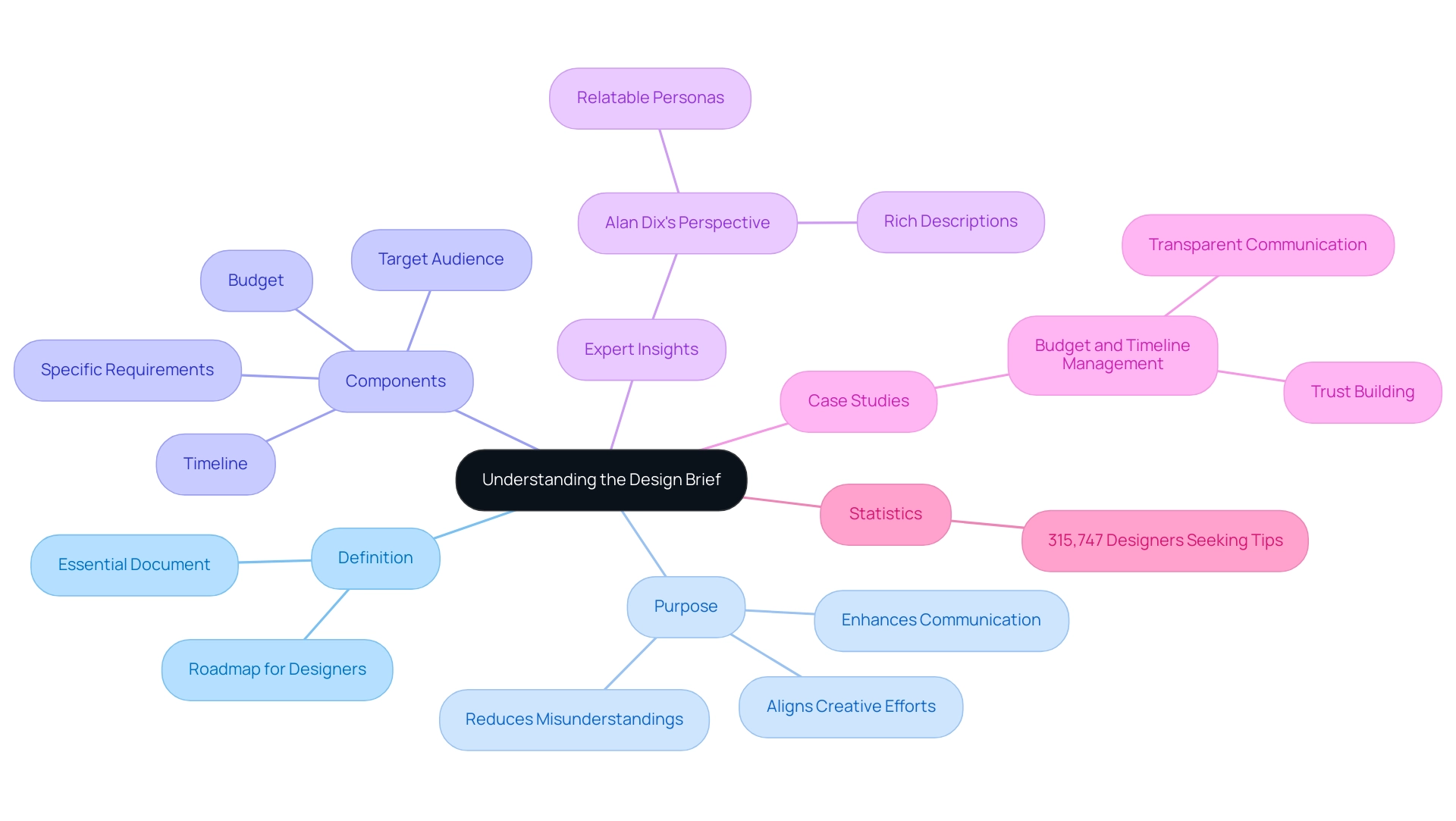
The Significance of a Design Brief in Branding Projects
At WonderEight, understanding the significance of a design brief is paramount, as this layout outline serves as a crucial foundation for branding initiatives, ensuring that all creative efforts align seamlessly with the company’s identity and goals. It articulates the organization’s values, mission, and target audience, equipping designers with essential insights that guide their work effectively. By establishing a clear framework, the project outline mitigates the risks of scope creep and miscommunication—factors that can jeopardize timelines and outcomes.
Furthermore, a well-structured project outline enhances collaboration among team members at WonderEight, ensuring that everyone is aligned with the project’s vision and direction. This alignment is vital for maintaining identity consistency across various promotional channels, a factor that 68% of companies associate with revenue growth of 10% or higher.
Case studies, such as Smoopydoo’s transformation through the Brand Blaze process, illustrate the effectiveness of a comprehensive creative outline. This process provided valuable audience insights and established strong positioning, resulting in increased customer loyalty and market share within just two years. Smoopydoo’s investment in marketing strategy and aesthetics exemplifies how a carefully constructed project outline can lead to substantial business results.
Moreover, robust employer identity, significantly influenced by a meticulously crafted project outline, has been shown to improve employee retention by as much as 28%. This not only reduces expenses associated with new hires but also fortifies the internal identity. Additionally, minor prompts, such as showcasing what others are purchasing, can greatly influence conversion rates, underscoring how creative outlines can shape both identity and marketing efficiency.
Ultimately, the importance of a creative outline transcends mere documentation; it acts as a strategic resource that synchronizes innovative efforts with identity, ensuring that every endeavor contributes to a unified and effective presence. As highlighted by Business Insider, the amount brands allocate for logo creation can vary dramatically—from nothing to millions—underscoring the necessity of thoughtful investment in branding initiatives at WonderEight.
Essential Elements of a Comprehensive Design Brief
A comprehensive design brief is crucial for effective project execution and should encompass several essential elements:
- Project Overview: This section provides a succinct description of the project, outlining its purpose and goals to set a clear direction.
- Target Audience: Detailed insights into the intended audience, including demographics and psychographics, are vital for tailoring the design to meet their needs.
- Brand Guidelines: Incorporating existing brand elements such as logos, color palettes, and typography ensures consistency and adherence to brand identity.
- Scope of Work: Clearly defining what is included in the project—and what is not—helps manage expectations and prevents scope creep.
- Timeline: Establishing key milestones and deadlines is essential for keeping the initiative on track. A case study on establishing timescales highlights the importance of setting realistic timelines and the need for flexibility and timely feedback from clients to avoid delays.
- Budget: An outline of the financial resources designated for the initiative is necessary to ensure that the creative team operates within financial constraints.
- Competitor Analysis: Insights into competitors’ branding strategies can inform creative decisions, allowing for differentiation and strategic positioning.
- Deliverables: Clearly stating the expected outcomes and what the creative team is to accomplish is crucial for clarity.
By integrating these components, brand managers can define what constitutes a design brief that not only directs the creative process but also guarantees alignment with overarching brand goals. Statistics suggest that clearly articulated outlines can result in a substantial boost in efficiency, with certain organizations noting up to a 40% rise in new monthly visits due to enhanced execution. Lina Lugova, CMO of Epsom, emphasizes, ‘A creative outline is only valuable if it captures the correct, relevant, and current information.’ This highlights the significance of a comprehensive and well-organized outline in attaining successful results.
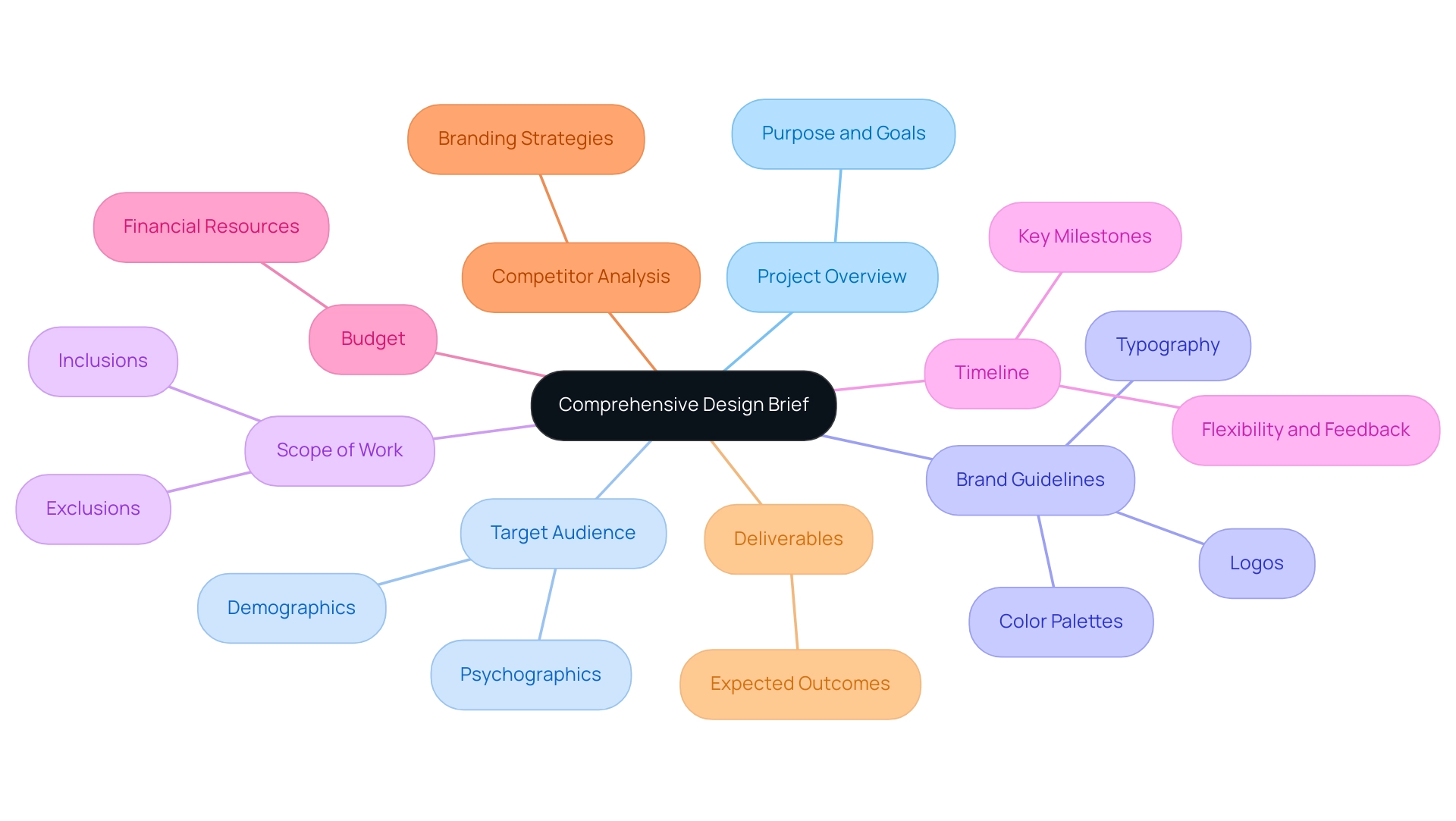
Design Brief vs. Creative Brief: Key Differences Explained
Design outlines and creative outlines are both essential guiding documents in the lifecycle of a task; however, understanding what constitutes a design brief is crucial for achieving successful outcomes. A design outline specifically tailored to define what a design brief entails encompasses the visual and functional elements of a design project. It meticulously details the requirements necessary for creating assets such as logos, websites, or marketing materials, ensuring that the visual identity aligns seamlessly with the company’s ethos.
Conversely, a creative outline adopts a broader perspective, encapsulating the overall strategy, messaging, and objectives of a marketing campaign. This document provides essential context for the creative team, ensuring that their efforts are in alignment with the organization’s goals and resonate effectively with the target audience. For instance, WonderEight’s extensive campaigns for companies like Miranda and Quaker Oats exemplify how a well-structured creative outline can yield captivating content that enhances visibility and fosters consumer connection.
The success of these campaigns underscores the importance of utilizing both documents effectively, as they work in tandem to drive impactful results.
Understanding the distinctions between these documents is vital for brand managers. Research indicates that initiatives employing a systematic outline can significantly enhance visual results. A study involving 25 graduate students revealed a clear correlation between effective problem formulation in concept ideation and successful task execution.
This highlights the importance of grasping what a design brief is to attain desired outcomes, particularly in light of WonderEight’s innovative approach that merges creativity with technology.
Moreover, successful projects frequently leverage both documents to maximize impact. For example, the identity enhancement for Castania and the digital campaign for Motorola demonstrate how integrating insights from both documents can lead to measurable outcomes. As researcher Stephanie V. Proule notes, “Innovation and creativity are prioritized in engineering solutions, yet engineers and creators must also confront complex challenges which are highly constrained by requirements, regulations, and limited resources.”
By effectively employing creative outlines, brand managers can ensure that all facets of the initiative are well-coordinated, ultimately enhancing business outcomes and elevating brand value.
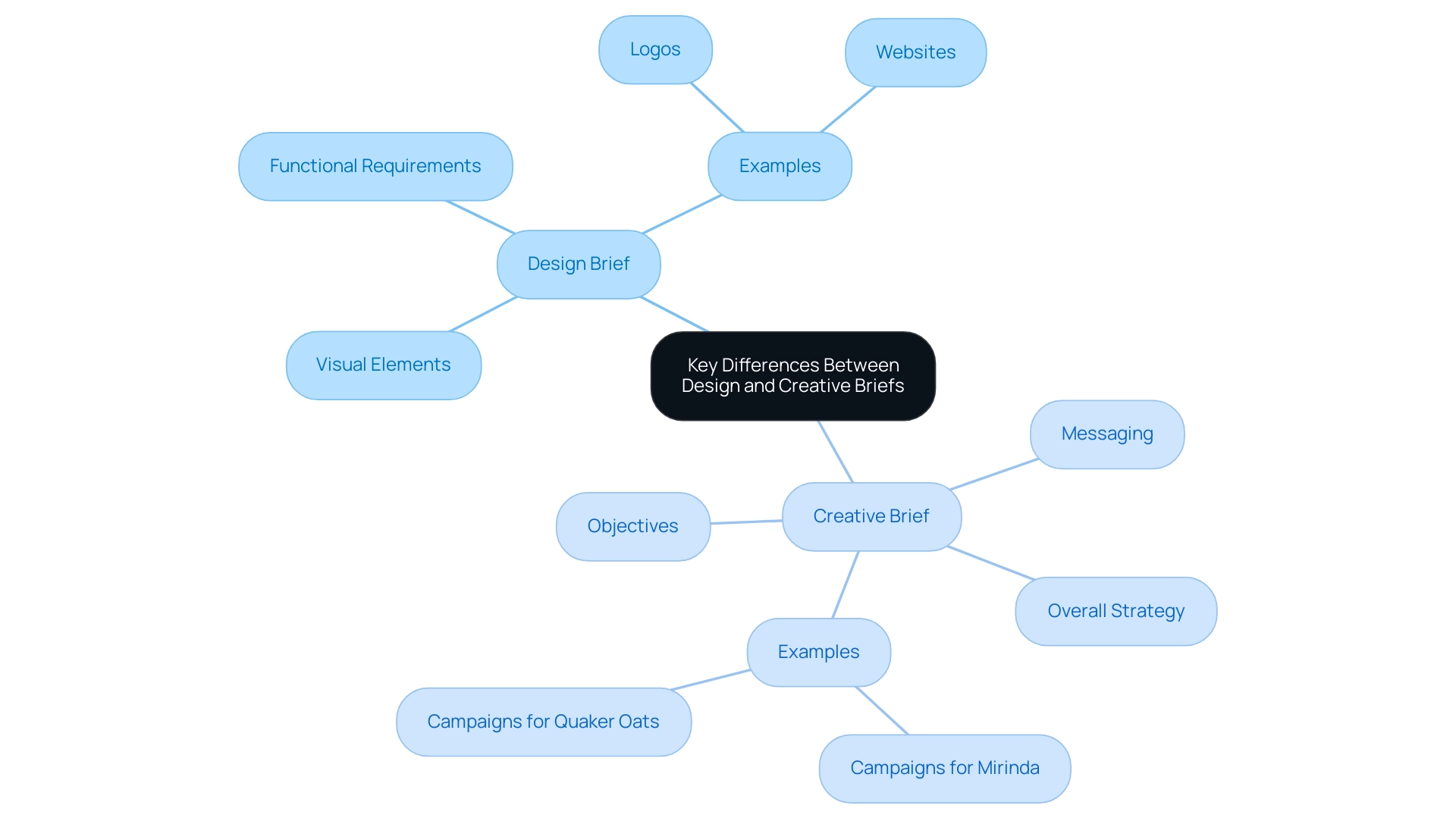
How to Write an Effective Design Brief: A Step-by-Step Guide
Crafting an effective design brief is essential for successful branding projects and involves several critical steps:
-
Define the Goals: Begin by clearly articulating the objectives of the endeavor. This clarity is essential, as studies indicate that initiatives with well-defined goals have a significantly higher success rate.
-
Research the Audience: Gain a deep understanding of the target audience’s needs, preferences, and behaviors. This insight will inform design choices and ensure the final product resonates with consumers.
-
Outline the Scope: Specify what the endeavor will encompass, including deliverables and any limitations. A well-defined scope helps manage expectations and resources effectively.
-
Set a Timeline: Establish clear deadlines for each phase of the endeavor. Timelines not only keep the initiative on track but also facilitate better planning and resource allocation.
-
Determine the Budget: Clearly outline the financial resources available for the undertaking. Budget considerations are vital for ensuring that the initiative remains feasible and aligned with business goals.
-
Gather Inspiration: Include examples of designs that align with the desired outcome. This can serve as a visual guide for the creative team and help clarify the vision of the initiative.
-
Provide a High-Level Overview: Include a brief background of the business or client, highlighting their unique selling points. This context is essential for understanding the project’s framework.
-
Conduct Competitor Analysis: Analyze competitors to identify market positioning and opportunities. This insight can guide creative strategies and help differentiate the brand.
-
Review and Revise: Collaborate with stakeholders to refine the document before finalizing it. This step guarantees that all viewpoints are taken into account, resulting in a more thorough and efficient project outline.
As Sarah Laoyan states, “A well-crafted outline will help offer mutual understanding regarding your objectives and deliverables.” By following these steps, managers can create comprehensive specifications that clarify what a design brief is, simplifying execution and improving the chances of attaining significant results. For instance, WonderEight’s comprehensive campaign for Quaker Oats illustrates how a well-organized outline can lead to strengthened market presence and consumer loyalty.
Likewise, successful initiatives such as the identity enhancement for Castania showcase the concrete advantages of dedicating time to developing a comprehensive project outline.
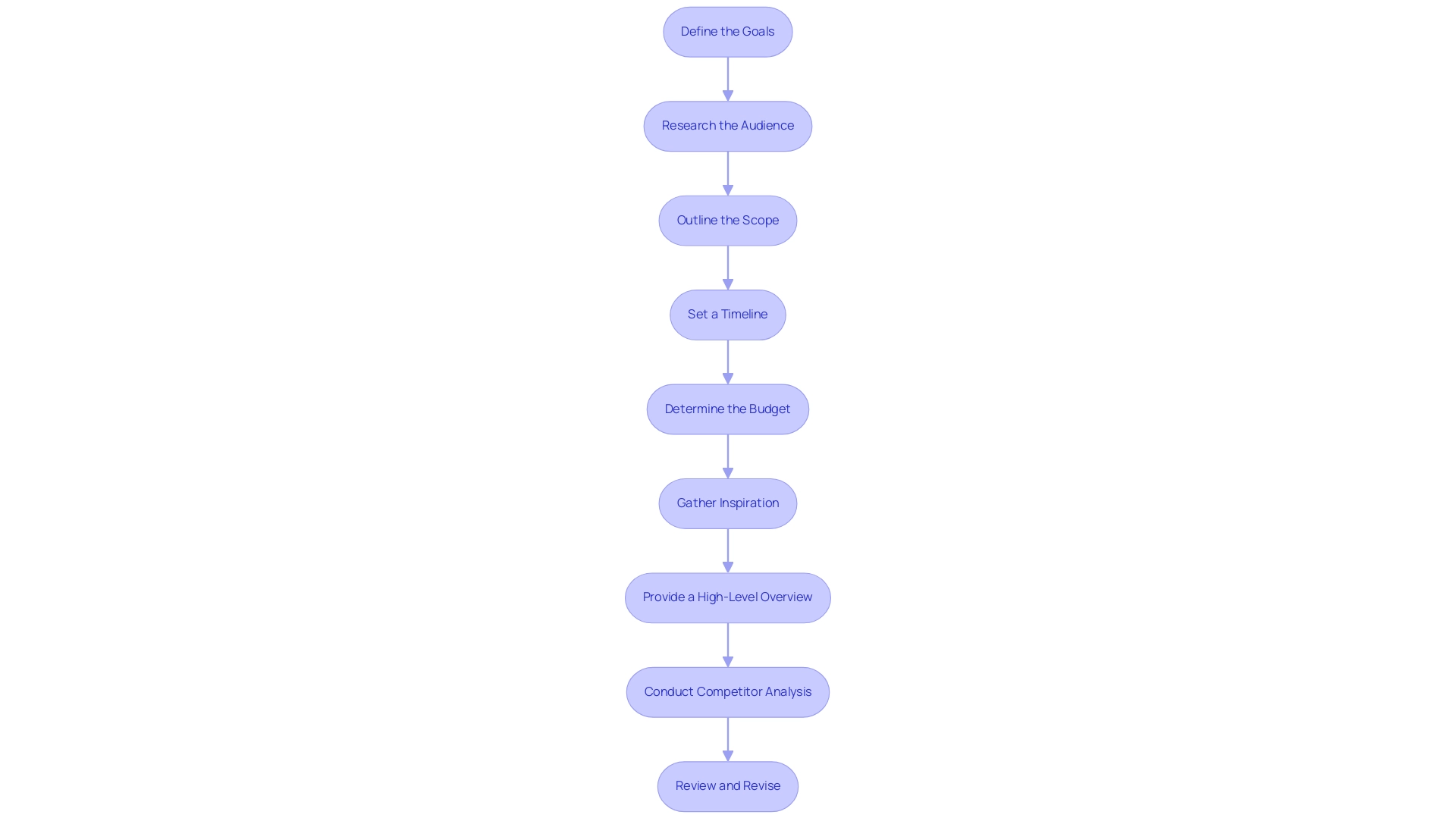
Overcoming Challenges in Crafting Design Briefs
Understanding what constitutes a design brief presents numerous challenges, including unclear objectives, insufficient stakeholder engagement, and inadequate research. To navigate these obstacles effectively, brand managers must adopt the following strategies:
-
Engage Stakeholders Early: Involving key stakeholders from the outset is essential. This collaboration not only gathers diverse perspectives but also fosters a sense of ownership and commitment to the endeavor.
-
Clarify Objectives: Clearly defined project goals are paramount. Objectives should be specific, measurable, and aligned with the overarching strategy to ensure that all efforts are directed towards a common purpose.
-
Conduct Thorough Research: A comprehensive understanding of the target audience and current market trends is vital. This research informs the summary and aids in crafting messages that resonate with consumers, ultimately enhancing brand visibility.
-
Iterate and Refine: Flexibility is crucial. Brand managers should remain open to modifying the outline based on stakeholder input and new insights, ensuring that the document remains relevant and impactful throughout the development process.
As Matt Lasky emphasizes, “how crucial it is to create a meticulously detailed document for successful web development projects.” By proactively addressing these challenges, managers can significantly elevate the quality and effectiveness of a design brief. Successful case studies, such as the comprehensive campaigns developed for Miranda and Quaker Oats, illustrate how well-structured documents lead to engaging content and impactful brand experiences that resonate with audiences.
Moreover, expert insights underscore the importance of stakeholder engagement, indicating that initiatives with active participation tend to yield higher quality outcomes. In fact, data shows that initiatives with clear objectives and thorough research are more likely to achieve measurable success, reinforcing the necessity for a meticulous approach to creating specifications.
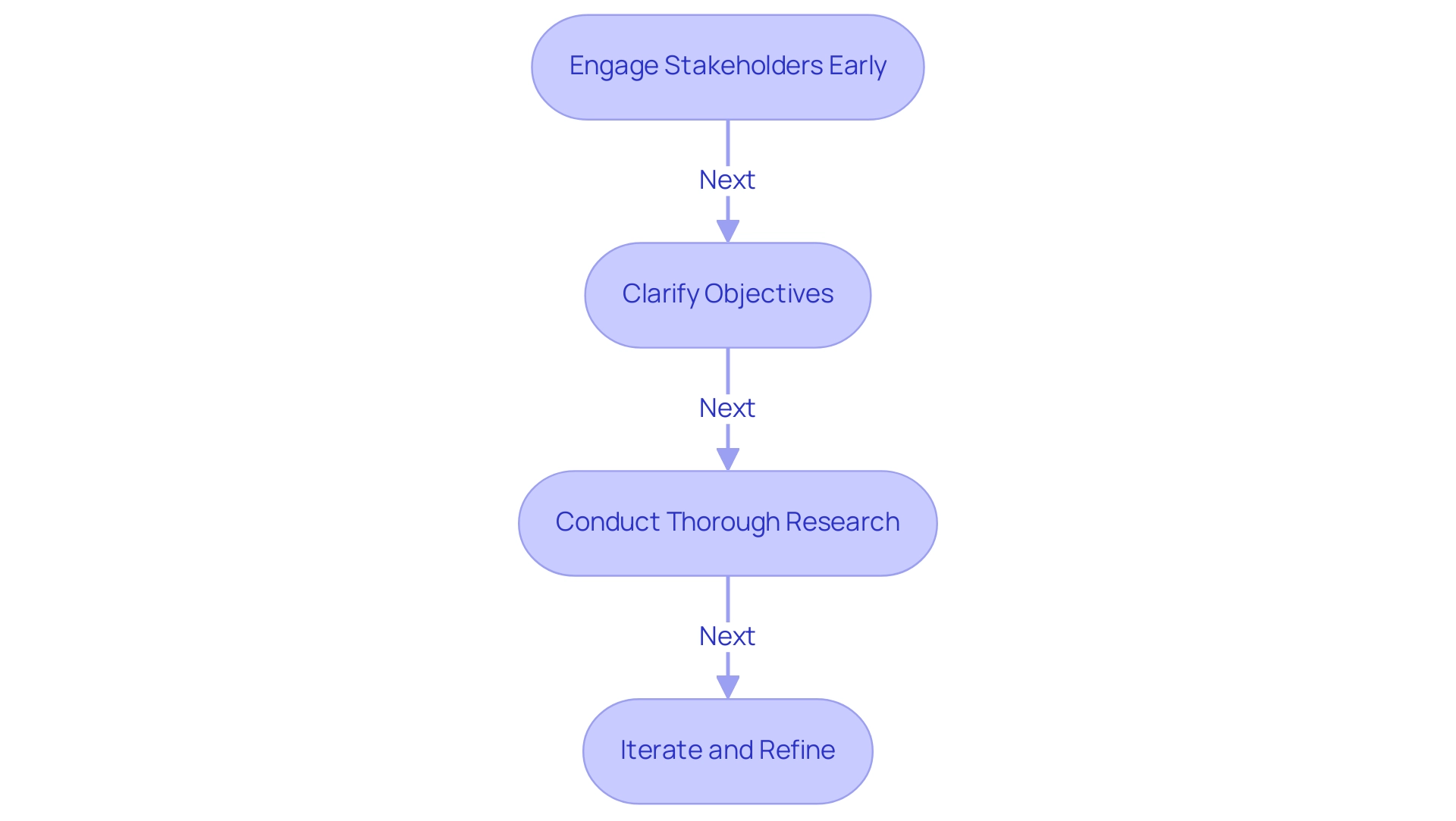
The Role of Collaboration in Developing a Successful Design Brief
Collaboration stands as a cornerstone in crafting a successful project outline, as it fosters open communication among team members and ensures the inclusion of diverse perspectives. Engaging in collaborative activities—such as brainstorming sessions, workshops, and regular progress check-ins—cultivates an environment where ideas can thrive and concerns are addressed promptly. This collaboration not only elevates the quality of the project outline but also instills a sense of ownership among team members, resulting in a more engaged and motivated group.
Statistics reveal that projects featuring cooperative outlines experience significantly higher levels of engagement. A survey involving 269 NPD managers highlighted that effective teamwork enhances the overall quality of the document, underscoring the organizational factors that influence integrated product development (IPD) diffusion. For instance, organizations prioritizing teamwork in their creation processes often report improved outcomes, as collaboration allows for the integration of emotional and symbolic values into the creation, rather than focusing solely on functionality.
Expert opinions further emphasize the critical role of collaboration in developing project outlines. By harnessing the collective knowledge of the team, brand managers can produce documents that not only align with the brand’s vision and objectives but also resonate with target audiences. Gallup’s findings indicate that managers account for 70% of the variance in employee engagement, reinforcing the necessity of effective teamwork in boosting engagement levels.
Case studies, particularly those highlighting strategic planning and innovation, demonstrate how collaborative efforts have led to successful branding projects, showcasing the tangible benefits of teamwork in the creative process. Initial findings suggest that the highest levels of involvement occur during verbal-only exchanges in co-located settings and through mixed communication in remote environments, further illustrating how various collaboration techniques can enhance the quality of project outlines. Ultimately, a well-crafted project outline, anchored in collaboration, serves as a powerful tool for achieving impactful branding outcomes.

Case Studies: Successful Design Briefs in Action
Many companies have effectively harnessed project outlines to realize their marketing ambitions. A notable instance is the rebranding initiative of a prominent beverage company, where a meticulously crafted plan facilitated the creation of a cohesive visual identity. This strategic alignment not only resonated with consumers but also significantly enhanced brand loyalty.
Similarly, a tech startup utilized a detailed outline to direct the development of its website, culminating in a user-friendly interface that markedly improved customer interaction. These instances underscore the critical role that clearly articulated project outlines play in fostering effective branding efforts and achieving measurable outcomes.
At WonderEight, we fully acknowledge the significance of a well-structured project outline in achieving branding success. Supporting this assertion, statistics reveal that in 2024, the global business technology and services platforms sector experienced an impressive 45% increase in value, underscoring the tangible advantages of investing in effective marketing strategies. Furthermore, the comprehensive campaign for Quaker Oats exemplifies how a clearly delineated project summary can lead to increased consumer engagement and loyalty, showcasing WonderEight’s effectiveness in strategic marketing.
Moreover, client success stories such as the identity enhancement for Castania and the digital initiative for Motorola illustrate the measurable results linked to effective project outlines.
As Ben Franklin wisely stated, “It takes many good deeds to build a reputation, and only one bad one to lose it.” This quote underscores the importance of maintaining a strong image, which aligns with our discussion on project outlines. What, then, is a design brief? It serves as a vital component that not only steers creative processes but also ensures that branding efforts yield lasting impressions and fortified customer relationships, ultimately enhancing overall brand value.
Conclusion
A well-crafted design brief is the cornerstone of successful design projects, functioning as a crucial communication tool that aligns the objectives and expectations of all stakeholders involved. By meticulously outlining essential elements such as project goals, target audience, brand guidelines, and budget, a comprehensive design brief streamlines the creative process and mitigates risks associated with miscommunication and scope creep. The significance of this document is further underscored by case studies demonstrating how effective design briefs have led to measurable business outcomes, including increased customer loyalty and enhanced market positioning.
The role of collaboration in developing a successful design brief is paramount. Engaging stakeholders early in the process fosters a sense of ownership and ensures that diverse perspectives are integrated into the brief. This collaborative approach elevates the quality of the design brief and enhances team engagement and motivation, ultimately leading to more innovative and effective design solutions. Organizations that prioritize teamwork in their design processes frequently experience improved project outcomes and stronger brand identities, as evidenced by various examples.
In conclusion, the importance of a strategic design brief transcends mere documentation; it is essential for achieving impactful branding initiatives in a competitive market. By investing time and effort into crafting comprehensive and collaborative design briefs, brands can ensure their creative efforts resonate with target audiences and contribute to a cohesive and powerful brand presence. As the design landscape continues to evolve, understanding and implementing effective design briefs will remain a key factor in driving success and fostering meaningful connections with consumers.
Frequently Asked Questions
What is the purpose of an outline in a design brief?
An outline defines what a design brief is by specifying the goals, range, and needs of a creative endeavor, serving as a roadmap for designers and ensuring that all stakeholders share a clear understanding of the aims and expectations.
How does an outline enhance communication in creative projects?
By elucidating what a design brief entails, an outline enhances communication between clients and creators, reduces misunderstandings, and aligns creative efforts with overarching business objectives.
What key information does a typical outline address?
A typical outline addresses essential information such as the target audience, timeline, budget, and specific requirements for the project.
Why are outlines important in project management for creative endeavors?
Research indicates that many creative projects fail due to the absence of a clear outline, highlighting the critical role of a design brief in project management and the successful execution of creative projects.
What insights do experts provide regarding project outlines?
Experts emphasize that a detailed project outline can transform abstract concepts into relatable personas, enhancing the project’s relevance to its intended audience and fostering trust between clients and creators.
How does a well-structured outline affect client-designer relationships?
Transparent communication regarding budget and timeline through a project outline leads to smoother execution and improved client relationships, increasing the likelihood of achieving desired outcomes.
What are the business benefits of maintaining a clear project outline?
A clear project outline mitigates risks of scope creep and miscommunication, enhances collaboration among team members, and contributes to identity consistency, which can be associated with revenue growth.
Can you provide an example of the effectiveness of a comprehensive creative outline?
The case of Smoopydoo illustrates that a comprehensive creative outline can lead to increased customer loyalty and market share, demonstrating substantial business results within two years.
How does a project outline influence employee retention?
A meticulously crafted project outline can improve employer identity, leading to better employee retention and reducing expenses associated with new hires.
What overall role does a creative outline play in branding initiatives?
A creative outline acts as a strategic resource that synchronizes innovative efforts with the organization’s identity, ensuring that every endeavor contributes to a unified and effective presence.



